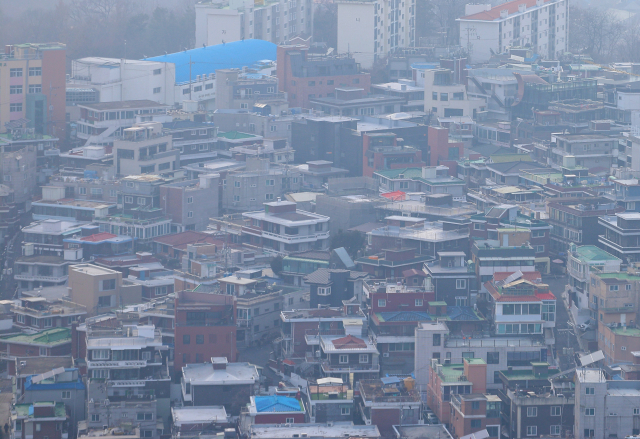Last year, villa rent increased by 0.6% while monthly rent rose by 1.3%,

View of the multi-family residential area in Yongsan, Seoul. Yonhap News
,
,
, ‘The jeonse price ratio (the ratio of jeonse price to sales price) for villas in Seoul is continuously declining. This trend persists as the sales price rises more significantly than the jeonse price, lowering the jeonse price ratio.’,
,
, ‘According to the Korea Real Estate Agency on the 27th, the average jeonse price ratio for Seoul rowhouses and multi-family homes (villas) in December last year was 65.4%, down 3.1 percentage points (p) from the same month the previous year. This is lower compared to the 68.5% recorded in December 2022.’,
,
, ‘Seoul villa jeonse price ratio rose to 78.6% in 2022 but fell to 68.5% in December of last year, and notably, in October 2023, it recorded the lowest level of 64.5% since the agency began disclosing jeonse price ratio statistics.’,
,
, “A falling jeonse price ratio can be interpreted as a reduction in the risk of losing the jeonse deposit. Generally, if the jeonse price ratio exceeds 80%, it becomes difficult for tenants to recover their deposit fully even if the property is sold, categorizing it as a so-called ‘can jeonse.’ Fraudulent jeonse can also frequently occur when the jeonse deposit exceeds the sales price, warranting caution.”,
,
, ‘The villa jeonse price ratio, which surged to 72% by the first half of last year (May), showed a continuous downward trend, dropping for five consecutive months since June. Reasons for the limited increase in jeonse prices include avoidance of jeonse due to the impact of jeonse fraud, with a preference for monthly rent expanding, and strengthened requirements for applying for a jeonse deposit return guarantee.’,
,
, ‘The rise in sales prices is also analyzed as one of the main reasons for the decline in the jeonse price ratio. According to the real estate agency, the sales price index for rowhouses and multi-family homes in Seoul rose by 1.03% last year, increasing more significantly than the jeonse price index (0.63%).’,
,
, ‘As the jeonse price ratio decreases, the impact of the Korea Housing & Urban Guarantee Corporation (HUG)’s policies to prevent reversed jeonse (when the jeonse deposit is higher than the house price) and enhance stability also seems to have played a part. A real estate expert explained, “If the jeonse price ratio is excessively high, it becomes difficult for tenants to move in, thus making it challenging for developers to sell, leading to a tendency for developers to lower the jeonse price ratio.”‘,
,
, ‘In Seoul, Gangseo-gu (74.3%), Yeongdeungpo-gu (73.7%), and Songpa-gu (73.0%) were cited as areas with high jeonse price ratios, while Yongsan-gu (46.1%), Jung-gu (57.0%), and Nowon-gu (59.8%) showed relatively low jeonse price ratios.’,
,
, ‘In the Gyeonggi region as well, the jeonse price ratio showed a downward trend. In December last year, the jeonse price ratio for villas in Gyeonggi decreased from 69.4% to 67.5%, a drop of 1.9 percentage points. On the other hand, Incheon showed a different trend, rising from 76.7% to 80.2% over the same period.’,
,
, ‘Meanwhile, among local governments nationwide, there were still many places where the jeonse price ratio exceeded 80%. These include Gwangyang in South Jeolla (88.9%), Paju in Gyeonggi (86.1%), and Michuhol-gu (85.4%), Namdong-gu (85.1%), and Yeonsu-gu (84.4%) in Incheon.’,
,
,

